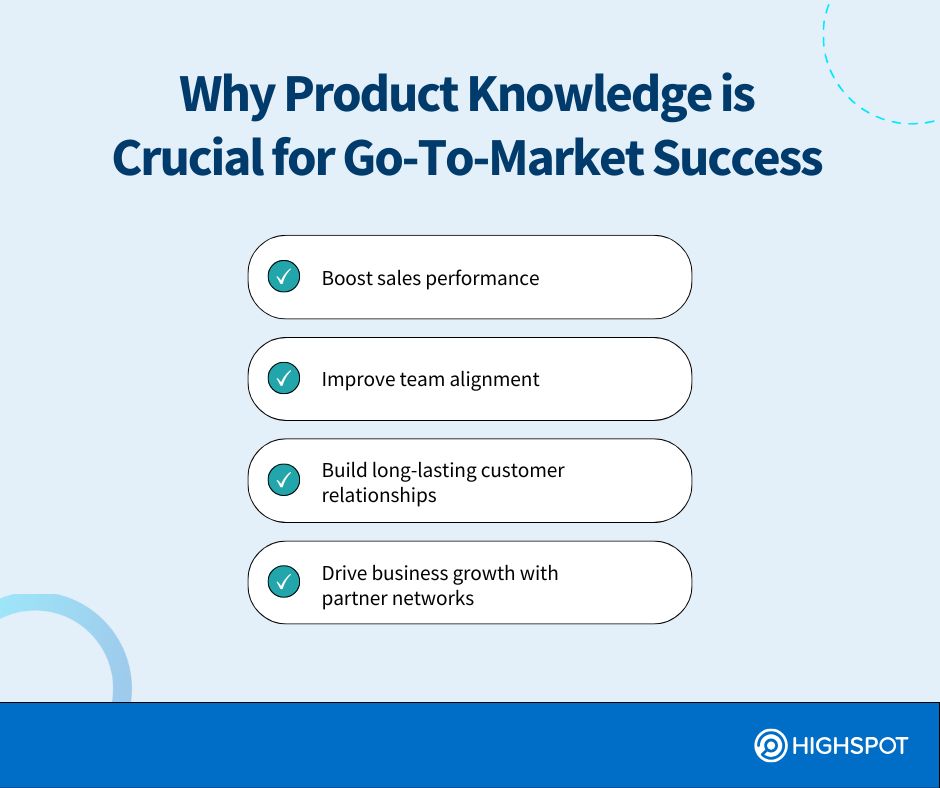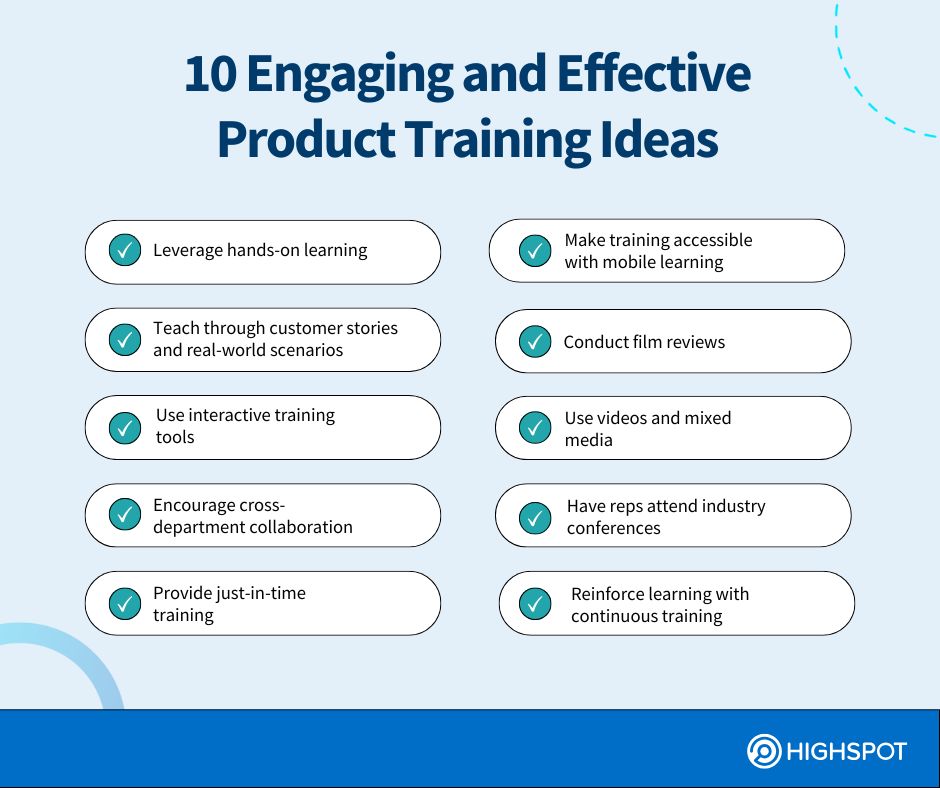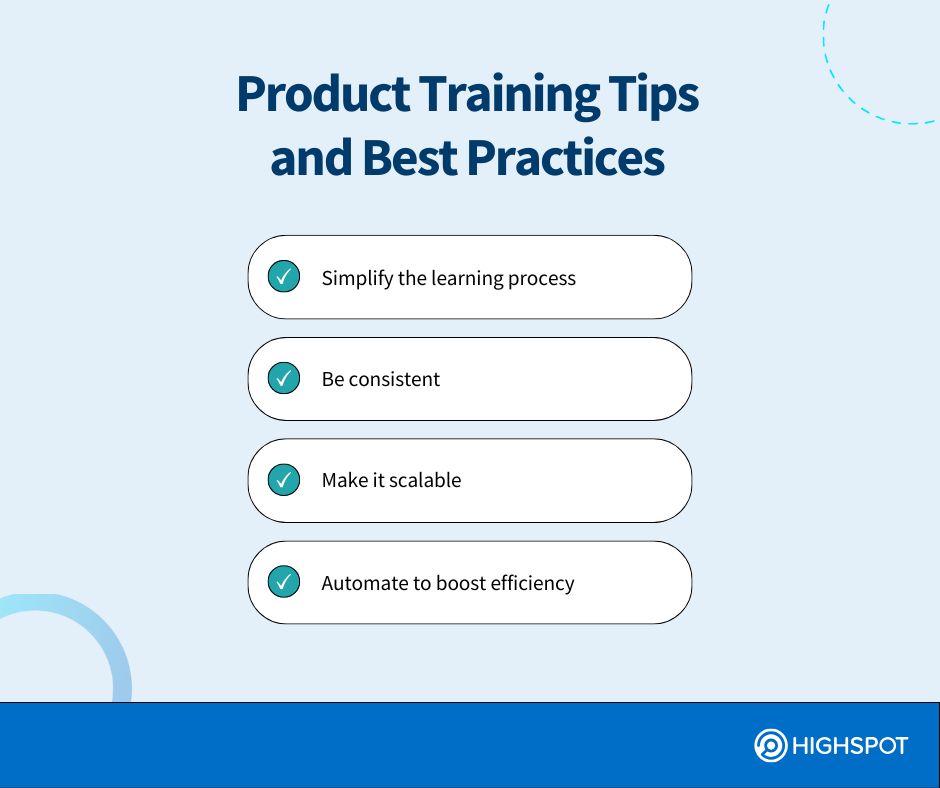Key Takeaways
- Product training is essential for anyone responsible for taking a product to market.
- 77% of B2B buyers found their most recent purchase “very complex or difficult,” emphasising the need for in-depth product knowledge.
- Product training techniques like gamification keep teams motivated.
Imagine for a moment that you are a buyer investigating a product. You ask a straightforward question about a feature or even ROI experienced by others in your same industry, and the sales rep stumbles. They get nervous, can’t offer a real answer, or suggest talking to a colleague instead. Does that inspire trust? Probably not. Buyers rely on sales reps as credible sources of truth, so you risk losing deals if your reps don’t truly understand the product.
This is where structured product sales training makes an enormous difference in performance.
This article provides actionable steps for developing an effective product knowledge training plan for new and seasoned sales reps. We’ll cover how to structure employee training, what to include in product knowledge training sessions, and even include a sample product training template and readiness checklist.
What is Product Training?
Product training is a structured learning process that helps team members understand, communicate, and sell a product. These sessions arm employees with thorough knowledge of features, benefits, value, practical use cases, and ROI.
A solid curriculum empowers:
- Sales to confidently build relationships, handle objections, meet customer expectations, and close deals faster.
- Marketing to connect what your product does to how it solves customer problems with compelling promotions and campaigns.
- Customer support to address customer queries and ensure adoption.
By aligning go-to-market (GTM) teams under one shared knowledge base, you equip each function—sales, marketing, customer support, and others— to seamlessly collaborate, maintain a consistent brand voice, and deliver outstanding customer experiences.
Why Product Knowledge is Crucial for GTM Success
Foundational product knowledge is essential in GTM planning, where decisions about sales channels, messaging, and engagement tactics directly influence your bottom line. According to Gartner, 77% of B2B buyers say their most recent purchase felt “very complex or difficult,” highlighting the importance of thorough product knowledge for anyone selling or supporting a solution.
When defining a GTM strategy, stakeholders must understand what the product does, whom it serves, and how it adds value. This knowledge will help them choose the proper channels, craft messaging, and address the problems your solution solves. Armed with this knowledge, teams can drive GTM success.
Below are a few ways product training sessions influence GTM:

1. Boost Sales Performance
When sales reps have extensive knowledge of your product’s unique differentiators, they can effectively communicate its value, making it much easier to win deals. Deep understanding also equips them to handle objections confidently and convincingly, addressing customer concerns. This level of expertise allows well-trained reps to pivot on the fly, tailoring their pitch to different buyer needs.
2. Improve Team Alignment
Consistent training programmes that standardise the product narrative keep everyone on the same page. Whether a sales rep is on a call or a marketer is crafting an online ad, consistent messaging prevents over-promising and under-promising and ensures a unified customer experience.
3. Build Long-Lasting Customer Relationships
Buyers gain confidence in your brand when sales reps can provide accurate, relevant answers immediately. That trust grows as reps use their in-depth understanding to suggest relevant features and benefits, helping buyers make informed decisions. Well-supported customers are likelier to remain loyal, fully adopt your product, and even act as advocates by recommending it to others.
4. Drive Business Growth with Partner Networks
Your resellers, channel partners, and distributors are just as important to GTM success as your sales force. They, too, need comprehensive product training to serve customers effectively.
Ensuring they have the same basic understanding of key differentiators, pricing, company offers, different sales techniques, and GTM strategies enables them to drive sales just as well as your direct sales team. Up-to-date, ongoing training also helps consistently spread brand awareness through all external materials and pitch decks.
Product Knowledge Training Objectives
A deeper understanding of the product benefits every role in an organisation, but different teams require varying levels of knowledge. Here’s a breakdown of how each function can leverage product training:
Product Training for Marketing Teams
Keep marketing in the loop with up-to-date product information so they can identify the target audience, create sales scripts, and develop compelling brand positioning and promotion strategies. Marketing’s job is to promote the product’s value so prospects will come and talk to you.
- Training focus: Product features, why the features were added, intent and value of the features, industry knowledge, and competitive differentiators. Marketing must decipher why your product is better than what’s already out there.
- Outcome: Marketing can craft compelling messaging, campaigns, and collateral that resonate with potential buyers and accurately reflect the product’s value.
Product Training for Sales Teams
Sales reps need comprehensive knowledge to present the product as valuable to prospects, address unique challenges, and handle objections.
- Training focus: Core features, unique selling propositions (USPs), ROI justification, competitive comparisons, industry knowledge, and practical demos.
- Outcome: A well-trained sales team can confidently address buyer questions and close deals faster, directly contributing to revenue growth.
Product Training for Customer Support
Customer support teams often serve as the first line of assistance when users encounter issues.
- Training focus: Besides product features, the training should cover troubleshooting steps and technical aspects, common user challenges, best practices for setup and usage, and how to escalate complex cases.
- Outcome: Equipping support teams with expert product knowledge leads to quicker resolutions, happier customers, and higher customer retention.
Product Training for Partners
Channel partners, resellers, and distributors extend your reach, but they need the right tools and product knowledge training materials to represent your product and brand effectively.
- Training focus: Pitch decks, competitive differentiators, pricing structures, and partner-exclusive resources (e.g., co-marketing materials). Providing partners access to your sales enablement solution will ensure they have access to the most up-to-date, relevant materials.
- Outcome: Well-informed partners can align with your core messaging, maintain brand consistency, and tap into additional revenue channels.
Product Training for Customers
Your customers’ understanding of the product should evolve as the product grows. Training sessions can be offered as part of an ongoing support subscription or a customer retention strategy through an online user group.
- Training focus: New feature rollouts, advanced use cases, optimisation tips, and opportunities for upgrades or add-ons, especially how they add value across specific use cases.
- Outcome: Ongoing training encourages long-term adoption, fosters upsell opportunities, and builds loyalty. You’ll also be able to collect real customer feedback to share with the product development team for enhancements to the product roadmap.
Types of Product Knowledge
With so many features, benefits, and industry applications to master, extensive product knowledge can feel overwhelming. However, learning doesn’t have to happen all at once. By starting with training foundations, like where to locate resources, top use cases, and how to quantify ROI, teams can gradually build the expertise and confidence they need.
Below are different types of product knowledge to consider when planning your training curriculum:
- Pricing and ROI: Understand how to justify pricing and quantify the value customers get in return. This could include cost savings, efficiency gains, or revenue growth potential.
- Features and benefits: Clearly articulate what the product does and why it matters to customers. For instance, if you’re selling a CRM tool, highlight how it centralises contact data, improving lead management and shortening the sales cycle by helping sales reps respond more quickly and minimise back-and-forth delays.
- Customisations: Show how the product can be adapted to different use cases. This might mean integrating other complementary solutions, modular add-ons, or specific settings that tailor the user experience, such as branding with colours and logos.
- Competitive landscape: Know your competitors, how you compare, and where you excel. For example, maybe your platform offers 20% faster onboarding than a top competitor or includes a necessary compliance feature that others lack. Having these specifics ready helps to position your product’s unique strengths.
- How to use the product: Hands-on practice ensures reps can demo the product and guide customers through use cases. This can involve access to sandbox environments, interactive walkthroughs, and perfecting a demo script.
- Support resources: Be ready to direct customers to online resources, help centres, or support teams. This includes knowledge bases, tutorial videos, and designated customer success managers who can assist with onboarding.
- Industry-specific applications: Tailor your pitch to fit specific verticals or buyer personas. For example, a healthcare use case might highlight HIPAA compliance and patient data security, while a manufacturing scenario could emphasise supply chain optimisation and real-time inventory tracking.
- Case studies: Use real-world success stories in the prospect’s industry to demonstrate credibility and ROI. Share metrics such as time saved, costs reduced, or revenue generated to show tangible outcomes.
- Frequently asked questions: Prepare reps for both business and technical FAQs. Consider buyers’ common roadblocks or misconceptions, and arm your reps with clear, concise responses.
- Roadmap: Keep reps informed about upcoming features and improvements. This will help maintain excitement and address potential future concerns, which is significant for buyers who depend on your solution as they scale their business.
How to Develop an Effective and Engaging Product Training Programme
Mastering the above knowledge areas isn’t something you accomplish on day one. Instead, you’ll want to build a training programme that offers incremental learning opportunities. By structuring your curriculum to evolve alongside your product, you’ll ensure your sales reps can confidently address buyer concerns.
Below are the key steps to help you build a robust product training programme:

1. Determine Who Needs Product Training
Are you onboarding new hires, upskilling experienced sales reps, or enabling partners? Conduct a product knowledge assessment and customise training based on roles, experience, and specific sales objectives so everyone receives relevant information.
For example, if you’ve just introduced a new product line, new hires might need the entire product suite overview, while seasoned sales reps only need training on recently added features. Meanwhile, partner teams may require a broad overview to co-sell, focusing on differentiators and integration points.
Sample Product Training Plan: New Sales Reps. Vs. Existing Sales Reps
Use this chart to help tailor product training for new and existing sales reps.
| New Sales Reps | Existing Sales Reps | |
|---|---|---|
| Primary goal | Establish a foundational understanding of the product, market, and sales process | Refresh and deepen product knowledge, sharpen essential sales skills, and stay updated on the latest features and market changes |
| Training focus | – Core product features & value propositions – Company messaging & brand guidelines – Basic competitive overview – Fundamental sales processes & CRM usage | – Recent product updates or product launch – Advanced competitive differentiators – Real-world success stories & best practices – Upskilling on evolving sales processes |
| Delivery methods | – Comprehensive onboarding sessions – Live demos for hands-on familiarity – Mentorship or “buddy” system – Microlearning modules for basic features | – Targeted refresher courses – On-demand e-learning for advanced features – Peer role-plays & call reviews – Gamified quizzes to reinforce new updates |
| Resources needed | – “Getting Started” playbooks – Simplified product cheat sheets – Intro-level competitor battle cards – Company mission and roadmap presentations | – Detailed battle cards with deeper competitive analysis – Customer case studies & ROI calculators – Advanced pitch decks & scenario-based training materials |
| Typical challenges | – Overwhelmed by new information – Unsure how to handle objections – Need time to adapt to internal tools & processes | – Risk of relying on outdated knowledge or “old habits” – Potential complacency with long-standing customers – Need to stay motivated and continuously improve |
| Measuring success | – Completion of onboarding quizzes & certifications – Demonstrated ability to articulate core product benefits – Early pipeline creation & deal progress | – Updated certifications for new products/features – Improved close rates & deal velocity – Higher customer satisfaction & upsell/cross-sell rates |
| Continuous support | – Scheduled check-ins with managers – Ongoing mentorship from experienced reps – Reference materials easily accessible in a sales enablement platform | – Regular refresher sessions (monthly/quarterly) – Role-specific coaching for advanced selling techniques – Peer-to-peer knowledge-sharing sessions |
2. Set Clear Learning Objectives (SMART)
Set targeted, measurable goals that outline what reps should learn, how to demonstrate it, and when to achieve it. Clear objectives simplify tracking progress for both sales reps and sales managers.
For example, a SMART goal could be: “Within 90 days, all new reps will conduct a complete product demo without assistance, validated by at least two practice demos per month and a final certification session.”
3. Break Training into Digestible, Engaging Content
Rather than overwhelming sales reps with lengthy sessions, divide information into bite-sized lessons (micro-learning) that tackle one topic at a time. This approach helps them retain more and feel less overloaded.
For example, dedicate a short module to a single feature, complete with a brief video demo and a quick quiz at the end. By spacing out lessons, you give them time to apply their new knowledge before moving on to the next topic.
4. Centralise Product Information in a Sales Enablement Platform
Store all resources, including playbooks, feature guides, and pricing calculators, in one place so your team can quickly access whatever they need. A robust sales enablement platform consolidates brand assets and learning materials, allowing sales reps to find, share, and customise resources without sifting through multiple folders.
5. Build a Structured, Interactive e-Learning Programme
Incorporate videos, quizzes, and interactive elements to keep all team members interested and to cater to different learning styles. Self-paced learning empowers them to absorb information at their own speed while tracking progress through dashboards or certifications. Although e-learning may not suit everyone, it offers valuable flexibility, especially for remote or travelling reps who can’t always attend live sessions.
6. Assess and Improve the Product Knowledge Training Programme
Collecting feedback from your sales team through surveys, Q&A sessions, or one-on-one discussions reveals whether your training materials truly resonate. Quizzes, role-plays, and real-world simulations also indicate how well reps can apply their knowledge. To keep the knowledge fresh, look for performance gaps and refine your program based on shifting market conditions or product updates.
Product Knowledge Readiness Checklist
A readiness checklist helps measure a rep’s product fluency while highlighting areas for further development. Encourage reps to fill out the checklist monthly, quarterly, or before events like sales kickoffs. Use results to guide coaching sessions and give public recognition when reps meet milestones.
| Checklist Item | Completed |
|---|---|
| Completed foundational e-learning modules | [ ] |
| Confidently demo the top three product features | [ ] |
| Understand how to quantify ROI for different buyer needs | [ ] |
| Familiar with at least two relevant case studies | [ ] |
| Reviewed competitive battle cards and differentiators | [ ] |
| Know where to find and update sales material | [ ] |
| Comfortable addressing the most common customer FAQs | [ ] |
| Have a clear escalation path for technical challenges | [ ] |
10 Engaging and Effective Product Training Ideas
Product training must be more than static content to keep sales reps curious and enthusiastic. Whether your team responds to gamified quizzes, hands-on challenges, or collaborative role-playing, the following sales training ideas will breathe life into your training.

1. Leverage Hands-On Learning
Give your sales reps the product to experience firsthand. One way to do this is to organise “sandbox sessions,” where they explore features, experiment with settings, and even troubleshoot hypothetical issues.
Live or recorded demos with product experts can also reinforce key points, and you can create mini-challenges where reps practise explaining the product to one another in different scenarios. For example, practise positioning the product to a cost-conscious buyer rather than a feature-focused buyer.
2. Teach Through Customer Stories and Real-World Scenarios
Tie product details to real customer success stories to make information more memorable. For instance, if a manufacturing client significantly reduced production downtime using your software, use this story to share specific data points and the steps they took to achieve that success.
Encourage role-plays where reps act out these scenarios, such as responding to a sceptical CFO who demands a clear ROI estimate. Linking the product’s impact to tangible results makes it easier for sales teams to personalise their pitch and handle objections.
3. Use Interactive Training Tools
Engagement skyrockets when learning feels more like playing than work. To motivate reps, incorporate gamification tactics, such as quizzes, contests, and leaderboards. Offer digital badges or small rewards for achieving certain milestones, like mastering a complex feature or beating the timer in a product configuration test.
You could even host friendly competitions within your GTM enablement platform—think trivia-style quizzes where the top scorer wins a gift card. These tools keep training lively and provide immediate feedback, helping reps quickly notice where to improve.
4. Encourage Cross-Department Collaboration
Cross-pollination of ideas often sparks innovative ways to highlight your product’s benefits. For example, you can invite product managers to host “office hours” and share the rationale behind new features or have marketers explain upcoming campaign angles to the sales team. A live Q&A session with engineering can clarify technical details that might stump a prospect. Meanwhile, shadowing a customer support call gives reps insight into common pain points and real-life use cases.
5. Provide Just-In-Time Training
Just-in-time training ensures reps have the correct information exactly when they need it. You can configure your sales training tool to deliver automated tips or pop-ups as they prepare for a demo.
Imagine a rep on a call with a prospect who suddenly mentions a newly uncovered competitor. AI-driven recommendations can instantly suggest a battle card or microlearning module with competitive differentiators and relevant talking points. With this real-time guidance, reps can address unexpected challenges immediately.
6. Make Training Accessible with Mobile Learning
Equip reps with online training course materials so they can learn on the go, whether commuting, waiting at the airport, or between client meetings. Offer downloadable content, such as short videos or playbooks for easy access. This flexibility is especially valuable for remote or travelling sales teams who can’t always join scheduled sessions. By meeting reps where they are, training remains top of mind and convenient.
7. Conduct Film Reviews
In the same way athletes watch game footage to enhance their performance, sales teams benefit from replaying and analysing actual calls. Sales call recordings can be shared in a weekly “film review” session, where the sales rep, manager, or entire team pinpoints successful conversation techniques, identifies sticking points, and brainstorms solutions. For instance, if a rep struggled to articulate the value proposition to a financially cautious buyer, the group could collectively develop more practical ways to frame ROI.
8. Use Videos and Mixed Media
Videos, infographics, and short animations can transform lengthy product explanations into brief, visually appealing lessons. For example, a two-minute animated video might explain how one of your key features automates data entry, saving reps from reading pages of technical documentation. More importantly, it maximises their attention and understanding.
Sometimes, seeing a feature in action is better, and sales reps are more likely to need to understand practical applications rather than behind-the-scenes tech. They can easily rewatch or pause these resources, making them convenient for quick refreshers.
Coupled with interactive quizzes or mini-assessments, mixed media content keeps learners interested and boosts retention.
9. Have Reps Attend Industry Conferences
Industry conferences offer a chance to stay informed about market trends, competitor tactics, and emerging technologies. They are also an interactive and fun way to meet peers and network with potential customers. Sales reps who attend can bring back new industry information, whether it’s a new way to position your product against a fast-growing competitor or a more compelling pitch for a particular vertical.
10. Reinforce Learning with Continuous Training
One-and-done training simply doesn’t cut it when products and markets change so quickly. McKinsey found that 87% of executives say they are experiencing skill gaps in their workforce or expect them soon.
Schedule regular check-ins to review product updates, run refresher sessions on important or new features, and share any new successes or lessons learnt. You might implement a monthly “innovation briefing” where product managers announce upcoming releases, followed by role-plays or quizzes to help reps adopt the changes.
Product Training Tips and Best Practices
Developing a robust product training programme is only the first step. You must ensure it remains accessible, scalable, and delivers long-term value. Below are some tried-and-true tips and best practices to help you keep your team at the top of their game.

Simplify the Learning Process
Start with the most critical selling points, then go deeper as needed. This prevents reps from feeling overwhelmed by every single feature or technical spec upfront.
For example, if you recently launched 12 new features, highlight the top three that deliver the most substantial ROI or address the most common customer pain points. Once reps master these essentials, you can gradually introduce the rest in follow-up sessions or advanced modules. This targeted approach keeps training sessions short, focused, and memorable.
Be Consistent
While the focus of training can differ for sales, marketing, and support teams, the core product information, such as positioning, key differentiators, and top use cases, must remain uniform. Prospects may receive mixed messages if one team highlights a certain feature as a primary selling point while another team barely mentions it.
A practical way to maintain consistency is to store and regularly update a centralised repository everyone can reference. This ensures that no matter who interacts with a prospect, they deliver the same accurate information.
Make It Scalable
Your training programme should grow with your business. It must be easy to update, expand, and adapt for new hires, seasoned reps, and partners. Self-paced modules and on-demand learning resources help ensure everyone can brush up on product knowledge at their own pace, which is especially for teams across different time zones.
For instance, you might set up onboarding sequences that drip-release training materials for new hires over the first few weeks while allowing experienced reps to “test out” certain modules if they already demonstrate adequate knowledge.
Automate to Boost Efficiency
Automation can take your training programme from good to great, particularly as your team grows. Use AI sales coaching tools to personalise training based on individual sales performance, automatically recommending practice scenarios where they may need extra help.
Sales kickoffs—quarterly or annual—are an ideal time to reinforce product training objectives, as they bring your entire sales force together and set the tone for the next quarter. By leveraging these events in your training process, you can introduce new features, address market shifts, and ensure every sales rep is aligned on messaging before heading back to their territory.
Plus, self-paced modules and ongoing refreshers between kickoffs allow your team to refine their knowledge at their own pace without sacrificing day-to-day responsibilities. This approach helps you maintain an ongoing, ever-evolving training programme.
Remember, practical product training is a continuous journey that fuels confidence and consistent performance across your GTM organisation. When your sales reps, marketers, customer support agents, and partners can articulate your product’s value and use cases, you elevate every buyer touchpoint, from first demo to contract renewal.
Combining the strategies outlined in this guide with a modern enablement solution like Highspot will equip your team with the tools they need to learn, adapt, and succeed in today’s fast-paced market.
Request a Highspot demo today!




